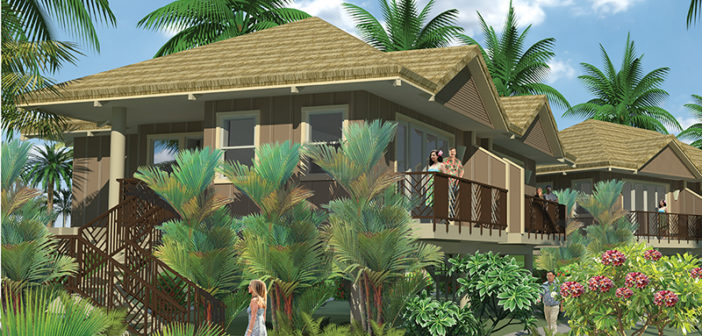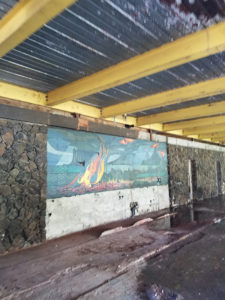WAILUA, KAUAI, HI—Two maverick developers in Hawaii are looking to mark their 10th year as a business team in 2018 by doing what no one has been able to do for the past 25 years: resurrect the iconic Coco Palms Resort here and re-establish it as a go-to destination via Hyatt Hotels’ Unbound Collection.
Not bad for a first hotel project.
Managing members Tyler Greene and Chad Waters are the duo behind Coco Palms Hui (Hawaiian for Group), an LLC umbrellaed by their symbiotic GreeneWaters group, considered one of the largest buyers of foreclosed properties at auction on the four major islands of Hawaii. Normally up to their elbows in bulk condo purchases, conversions, subdivisions and new-build projects, the developers are now hip-deep in vertical construction plans for the resort. They recently completed a $3.5-million select demolition of unsalvageable buildings and the clearing of grounds and paths overgrown by vegetation following years of neglect, instigated, according to most accounts, by the arrival on Kauai Sept. 11, 1992, of Hurricane Iniki, a Category Four storm that severely impacted the area and forced Coco Palms to close.
Kauai itself suffered some $1.8 billion in damages, including power outages, severe flooding, residential/business destruction and insurance company bankruptcies. It was subsequent actions—make that non-actions—concerning the property’s renovations that exacerbated its closing, leaving Coco Palms in limbo for years.
As time went on, the resort was subject to vandalism and plundering of its vintage decor, including tile work and its signature giant clamshell bathroom sinks. “What did ensue was a 13-year lawsuit with the insurance company, from 1992 to finally being resolved in 2005. We know they did get insurance proceeds. We don’t know what the amount was, but immediately they sold it,” said Waters.
Attempts by a variety of entities to redevelop the property faced several challenges, not the least of which were recessionary cycles in the early 1990s and again in 2008/9, as well as the impact on travel and hotels by the Sept. 11, 2001 terrorist attacks on the United States. In addition, small portions of the property, which houses one of the largest coconut groves in Hawaii, are owned by the state. Also, activists have been vocal about the land’s history vis-à-vis redevelopment, citing the area as home to the last Kauai royal, Queen Deborah Kapule.
Twenty years after Iniki had her eye on Kauai, Waters and Greene trained their sights on Coco Palms in 2012, frequently passing the dilapidated resort as they worked on a timeshare-to-condo conversion project. The project’s architect at the time also was working for the owner of the resort, Coco Palms Ventures LLC, trying to parse a plan for the property, which it had acquired in 2006 with ambitious redevelopment plans that became moot in the subsequent economic downturn of 2008/9.
“He connected us with the ownership group, which was a partnership between Prudential Investments and an East Coast developer named Petrie Ross Ventures,” said Waters. The partnership later sold the resort to Coco Palms Hui for a reported $23 million.
“The previous owner gave us some very good terms on the project and they remain as an equity partner to date,” said Waters. “It was good timing for us, good timing for the market cycle.”
“We believe Coco Palms represents the idea of genuine aloha and I would say, old-school Hawaiian hospitality. It’s our hope to bring that back in a modern-day way,” said Greene of the $135-million project, which is a private venture with investors still being invited to participate.
The capital stack includes sponsorship and institutional equity as well as institutional debt. The sponsorship equity may include what’s called a Regulation D Fundraise, a public offering for smaller investors to be able to come in at a minimum investment of $100,000.
“This was our way of allowing that local investor that had an attachment and an affinity toward Coco Palms to be able to participate in the process,” said Greene, adding, “It’s kind of an over-glamorized crowdfunding that is monitored through the SEC.”
“I don’t think we would have taken on another large project of this magnitude if it wasn’t Coco Palms simply because the pent-up demand is really huge. We’ve got 25 years of people wanting to stay at Coco Palms and from a development standpoint to have that kind of demand sure makes the project a lot easier,” said Waters.
Once a beauty queen among the resorts that made Hawaii such an exotic Technicoloresque experience for travelers and celebrities during the 1950s and ’60s, Coco Palms began as a lodge in 1953 with 24 rooms, later dropping the descriptor under the management of Grace (nee Buscher) and Lyle L. (Gus) Guslander (owner of the Island Holidays chain), who expanded the resort to more than 400 keys by the 1970s.
Stars of the day, ranging from Frank Sinatra, Liberace and Bing Crosby to Olympic gold and silver medalist swimmer Duke Kahanamoku, a Hawaiian legend considered the father of modern surfing, stayed there.
The resort served as backdrop for several major motion pictures. In 1961, the Coco Palms Resort was featured in the Elvis Presley movie Blue Hawaii, which showed some of the resort’s traditional Hawaiian activities such as the torch-lighting ceremony and conch shell blowing and highlighted the Coco Palms wedding chapel. The developers hope weddings—some 500 a year back in the day—will once again be a top revenue generator when Coco Palms reopens. The same goes for No. 56, the bungalow where Elvis stayed.
The revamped Coco Palms, which sits on 46 acres, will offer 350 rooms and suites, including 11 duplex bungalows that each contain two master suites. Ron Agor of Agor Architects is the architect of record, collaborating with global firm WATG, which originated in Honolulu, and did the original Coco Palms design. Mary Philpotts McGrath of Oahu-based Philpotts Interiors, whose grandmother was good friends with Grace Gutlander, is doing the interior design.
The developers have been able to keep some 200,000 sq. ft. of building shells, although a July 4, 2014 fire at the property did still more damage.
While celebrated and recalled for its vintage vibe, Coco Palms Resort is not going to be a re-creation of what once was, although the developers are looking to save the lava rock walls throughout the resort.
“We have a mantra that we stick to in the course of this journey: Honor the past, but celebrate the future,” said Greene, noting it ties into the property’s contemporary retro design aesthetic. There’ll be many, many ways we can do some hints and throwbacks to those ‘golden days,’ but it will be a modern-day hotel.”
So no giant clamshell sinks?
“We’re not able to use them because of current hotel standards. We still have some of those sinks though and we will integrate them throughout the property, maybe as a water feature or as a planter out in the coconut grove,” said Greene.
“Part of the motivating factor for us is we really believe Coco Palms is not only essential to close the chapter on Iniki for the island of Kauai, but also for the State of Hawaii. We believe through this process you’ll see a very serious revitalization and a new-found energy in that Wailua-Kapua corridor, which we really think will transform what is happening in the hospitality industry here in Hawaii. We believe that will send a ripple effect throughout all the major islands and change the way customers experience Hawaii and also hopefully change the way hoteliers look at what it is the customers should be given and want out here on their trips to the island,” said Greene. HB



